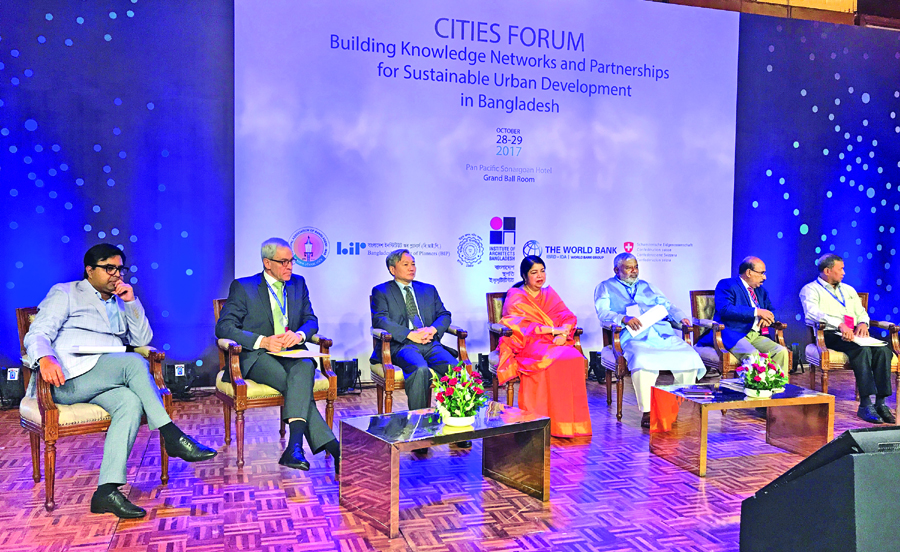
Participants in the inaugural session of the two-day international conference on 'Cities Forum: Building Knowledge Networks and Partnerships for Sustainable Urban Development in Bangladesh' that began at a city hotel on Saturday. Speaker Dr Shirin Sharmin Chaudhury attends it as the chief guest. — FE Photo
The rate of urbanisation in Bangladesh is still lower than that of many other countries, including some in South Asia.
Also, the country has 6.5 million housing deficit and about 8.0 million people (19 per cent of urban population) live in informal settlements in urban areas, which poses an obstacle to achieving the Sustainable Development Goal (SDG-11).
Experts revealed the figures at the two-day international conference entitled 'Cities Forum: Building Knowledge Networks and Partnerships for Sustainable Urban Development in Bangladesh' that began in the city on Saturday.
According to the Bangladesh Bureau of Statistics (BBS) 2011 report, the urbanisation rate was 28.4 per cent, and the UN Department of Economic and Social Affairs put the figure at 33.5 per cent in its 2014 report.
Experts said the growth of informal settlements and employment is concentrated in few cities, mainly in Dhaka which has become the centre of politics, education, business and employment.
More than 42 million people live in 517 urban centres and the number of urban population will outpace the rural population by 2045, they said at the conference's second plenary session on urban planning and sustainable infrastructure.
The World Bank in collaboration with the Municipal Association of Bangladesh (MAB), Bangladesh Institute of Planners (BIP), Institute of Architects, Bangladesh, and the Institution of Engineers, Bangladesh, has organised the event that is being sponsored by the Swiss Agency for Development and Cooperation.
BIP general secretary Prof Akter Mahmud presented the keynote paper entitled 'The Challenges of Urban Planning in Bangladesh Today'.
Prof Mahmud said Bangladesh has a lower urbanisation rate than the global average, even it is lower than the rates in Asia and Africa. The global urbanisation rate is about 54 per cent while it is 48 per
cent in Asia and 40 per cent in Africa.
Bangladesh also lags behind its South Asian neighbours like Bhutan (38 per cent), Maldives (45 per cent), Pakistan (38 per cent) but ahead of India (32 per cent) and Nepal and Sri Lanka (18 per cent).
He said the population density in Dhaka is 0.14 million per square kilometre, which makes it one of the fragile cities in terms of availability of good public transportation system, public places and spaces, inadequate public utility services, etc. The nearest density is found in Mumbai which is 83,800.
He stressed the need to focus more on urban centres with relatively balanced population, as Dhaka adds 0.5 million people to its existing population every year.
"We have 28 urban centres with 0.1 million to 1.0 million population and 63 centres with 50,000 to 0.1 million population. These are the centres where we should focus and plan to reduce pressure on large urban cities (Dhaka, Chittagong, Khulna)."
Prof Mahmud said Bangladesh will not be successful in achieving SDGs by keeping the local government institutions (LGIs) isolated or weak and less participatory.
In another presentation on 'Sustainable Mobility & Cities: Lessons for Bangladesh', Prof Robert Cervero of University of California, Berkeley, identified under-developed road infrastructure, substandard physical plant and little rationalisation or hierarchy as sources of traffic congestion.
Other reasons are few sidewalks, overcrowded public realm, markets and bus terminals at critical intersections, lack of off-street parking facility, push-carts for goods movement and motorcycles encroaching on pavements, he added.
Besides, cars occupy 60 per cent and buses 20 per cent of road space of Dhaka.
Prof Robert said Dhaka metropolitan area has 85 per cent narrow roads, 7.0 per cent primary, 5.0 per cent feeder and 4.0 per cent secondary roads, which are quite poor compared to those in many other countries.
msshova@gmail.com